Root-knot nematode
Meloidogyne spp.
Profile
Root gall flukes are highly specialized nematodes whose females live in the roots of their host plants, causing them to form spherical swellings called root galls. Root gall eels are commonly called species of the genus Meloidogyne. Worldwide, they are responsible for significant yield damage in arable crops, ornamentals, and especially vegetables. They have a wide host plant range, making control with crop rotation measures very difficult. Since all these species show a very similar way of life, the basics of the species Meloidogyne hapla, which is native to our country and described in more detail below, also essentially apply to them.
Appearance
The pear-shaped swollen females are about 0.5 mm in size, white in color and sessile. The oval eggs, which are in the egg packets are about 0.07 mm long. The larvae of the second larval stage are about 0.4 mm long, transparent and colorless as well as the males, which remain freely mobile. The buttoned mouth spine of the larvae is delicately formed.

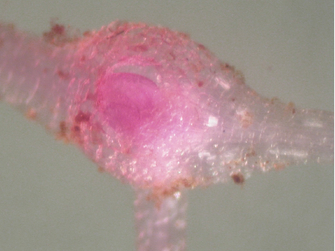
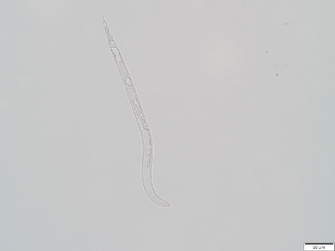

Biology
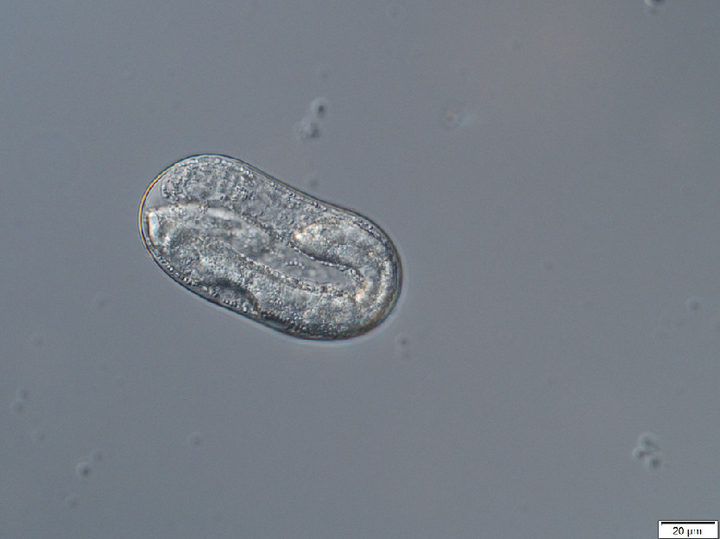
The pear-shaped swollen females live inside lateral roots and cause the surrounding tissue to swell, which envelops the nematodes like a gall. Only the hind end protrudes to the outside, which emits an egg package in the form of a jelly plug. Inside, 300 - 500 transparent oval eggs are found in large quantities. While still in the egg case, the nematode larva sheds its skin to form the second larval stage, which eventually emerges into the open.
This hatching is primarily controlled by soil moisture and ambient temperature: the optimum is 21 °C. From a temperature of about 10 °C, the larvae become active and search for new roots - they can travel up to one meter in the soil. Just behind the tip of the root, in the so-called growth zone, the larvae penetrate the root and continue to move around a little inside.
To feed, the larvae pierce the plant tissue with the help of their hollow mouth spine and suck out the cell contents. In the process, saliva is also secreted, which leads to the formation of so-called giant cells: these are large cells that have been "converted" and now serve entirely to feed the nematodes. They form the basis for the fact that the nematode larvae now no longer have to - or can - move around.
Whether a larva develops into a male or a female is influenced not only by hereditary factors, but also by the environment: under poor conditions, such as starvation, overpopulation, poor host plants, etc., males develop preferentially. However, there are also populations of root gall eels that can reproduce by so-called virgin reproduction, i.e. reproduction without previous mating. During development into a female in the root, the larval body swells pear-shaped after several molts. Only the tail end then protrudes outward. The filamentous males must leave the host plant to live freely in the soil.
Development occurs above a temperature threshold of 8°C and requires about 330-360 days to complete the entire cycle. After infestation, infective stages remain in the soil for up to two years.
Damage symptoms
The root galls develop as a reaction of the plant to the sucking of the root gall lice. Root galls ranging from a few millimeters to large (depending on the nematode and plant species present) are formed, and these can also fuse together in heavy infestations. This can result in irregular root thickening. On carrots, they grow to only millimeters in size and are usually located at branching points of the roots. Damage usually occurs in herds. Infected plants initially show a reduction in growth. As a result, stunted growth may occur. In case of heavy infestation, the host plants remain small and produce only low yields. In carrots, salsify and beets, severe deformities may subsequently occur. On potato tubers, small bumps form on the tuber surface.
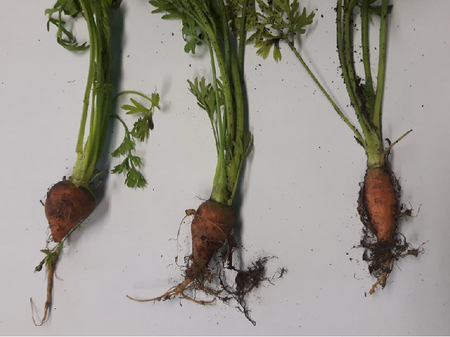
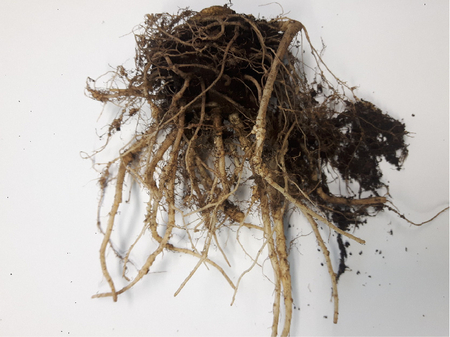
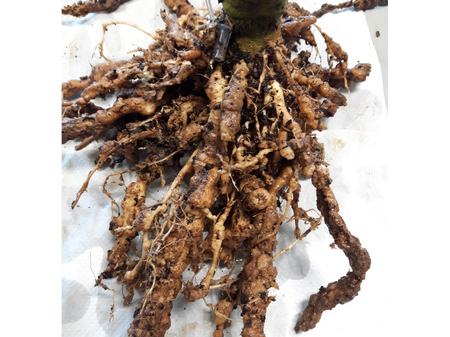
Host plants
Northern root gall(M. hapla) can live on more than 550 host plants, including numerous crops, such as potato, sugar beet, clover, alfalfa, collard greens, pea, field bean, carrot, parsley, chard, sunflower, salsify, parsnip, celery, onion, lettuce, tomato, strawberry, and grapevine. Damage to root vegetables, such as carrot, is very noticeable. Cereals, on the other hand, are not host plants and therefore this nematode species is not important in cereal crops. Root vegetables are particularly sensitive because the formation of the beet is impeded: for example, infested carrots remain only short, and often they are also branched, which severely impairs their market value.
Distribution
In the soil free-moving larvae, of the second stage of development can actively migrate vertically and horizontally.
Root gall eels are very widespread, especially in the tropics and subtropics. A few species may also live in temperate latitudes, such as the northern root gall eel Meloidogyne hapla, which also lives in our region. Three species of tropical root gall eels (M. incognita, M. javanica, M . arenaria) are found in greenhouses in our country.
Prevention and control
Measures in the open field against M. hapla:
- Use of healthy seedlings if it is a "planting crop".
- Avoidance of toleration by tillage implements, tractor tires, shoes, boots, ...
- Cultivation of non-host plants in the crop rotation (corn, cereals)
- Weed control
- Catch crop cultivation of a susceptible crop (e.g. oil radish) The effect is improved by turning over the crop after about six weeks (Hallmann et al. 2007)
- Cultivation of the marigold(Tagetes patula)
- Biofumigation
Phytosanitary status
The species Meloidogyne chitwoodi and Meloidogyne fallax are listed as Union quarantine pests and are thus subject to legal regulations to prevent their introduction and spread into or within the member states of the EU.
Specialized information
In addition to the species discussed above, M. hapla, which is native to our area, tropical root gall eels, such as Meloidogyne incognita, M. javanica , and M. arenaria, can cause damage in greenhouses. Their biology is very similar to that of M. hapla, but they are more heat-dependent. The optimum development temperature here is around 25 to 30 °C. All crops under glass are at risk, especially cucumbers, tomatoes and lettuce. Infected plants initially show reduced growth, followed by stunted growth or lack of head formation in lettuce. At high temperatures, numerous generations of these nematode species develop each season.
The gramineous root gall nematode(Meloidogyne naasi) is an important pest of cereals (oats, barley, rye, wheat) and cultivated grasses, and occasionally occurs on sugar beet and onion and other crops. Recent reports also refer to damage caused in sports turf and golf turf by this nematode species. In Europe, records of the gramineous root gall nematode are currently known from Belgium, the Czech Republic, Denmark, France, Germany, Hungary, Ireland, Italy, Malta, the Netherlands, Norway, Poland, Serbia, and Sweden. An occurrence for Austria has not yet been proven but cannot be excluded.
The root gall calf M. graminicola was detected in several rice fields in northern Italy in 2016. To date, its occurrence in Europe is restricted to the areas of Lombardy and Piedmont. An occurrence is known mainly from Asia, but also from parts of North and South America and parts of Africa. M. graminicola has a wide host plant range with over 90 host plants which are mainly found in the plant family Poaceae (cultivated plants as well as wild grasses) and some cultivated plants from the families Astaraceae, Cucurbitaceae, Fabaceae and Solanaceae, the economically most important host plant is currently rice.
The root gall calf M. minor was described in Holland in 2000 after a very severe infestation occurred on potato roots. In 2001, further detections of this root gall calf followed from Ireland and the UK following damage to golf turf. M. minor causes severe quality defects. Reports of occurrences of this species in Europe are available from Belgium, Ireland, Holland, Portugal, Sweden, and Great Britain. The host plant range primarily include various species of grasses, potato, and hop clover.
Meloidogyne mali is a root gall aphid that can also cause damage to trees and shrubs. It was first described in 1969 on apple trees in Japan. Host plants include, for example, species of Acer, Ulmus, Malus, Prunus, Vitis....
Last updated: 23.10.2024
automatically translated